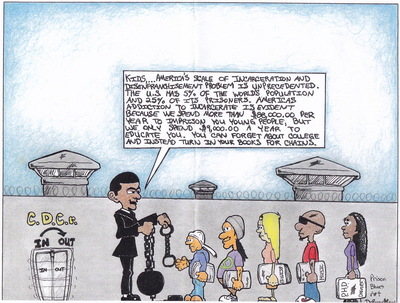
U.$. Still #1 in Imprisonment and Criminal Injustice

In December 2011, the Bureau of Justice Statistics released its
annual reports on the correctional population in the United $tates.(1)
The reports cover people under adult correctional supervision in 2010.
For the second year in a row, this population declined; the first
decline since the number of people in jail and prison began growing in
the 1970s.
At the end of December 2010, the total number of people in the correctional system, including probation, parole, prison and jail, was 7,076,200. The prison population in this country dropped .6% from 2009, the first decline since 1972. The number of federal prisoners actually increased by .8% but the state prison population dropped by that same rate. Because there are more state prisoners than federal prisoners, there was a drop overall.
The imprisonment rate for new convictions has been declining since 2007, but this is the first year releases exceeded admissions of prisoners, leading to the small drop in the prison population. But release rates were down 2.9% in 2010, so these numbers don’t reflect an increase in releases. In fact, time served by state prisoners remained about the same.
These latest numbers may indicate that the prison population has finally reached its peak in Amerika, possibly because of the heavy economic burden of maintaining such a massive criminal injustice infrastructure in this country. But even if the imprisonment rate continues to drop, it will take many years and huge changes before it gets low enough to be comparable to other countries. The U.$. holds over 30% of the world’s imprisoned people and has the highest imprisonment rate in the world.(2)
The report gives two possible explanations for the drop in prison population in the United $tates: “either a decrease in the probability of a prison sentence, given conviction, or a decrease in the number of convictions.” Unfortunately, data on these measures are not yet available but either would be a good thing. However, as mentioned above, it is likely these changes are a result of financial requirements, not a shift in politics around imprisonment.
There are some interesting trends by nationality demonstrating a continued commitment to national oppression by the criminal injustice system in Amerika. Blacks and whites both had a drop in imprisonment rates, but the decrease for whites (6.2%) was much bigger than for Blacks (.85%). In recent years migrants have been the fastest growing population in U.$. prisons. While 2010 saw a 7.3% increase in the “Hispanic” imprisonment rate, non-citizens actually saw a slight decrease, probably due to a massive increase in deportations. Black men remain the largest sector of the prison population and are imprisoned at a rate almost 7 times white men.
Related Articles:








